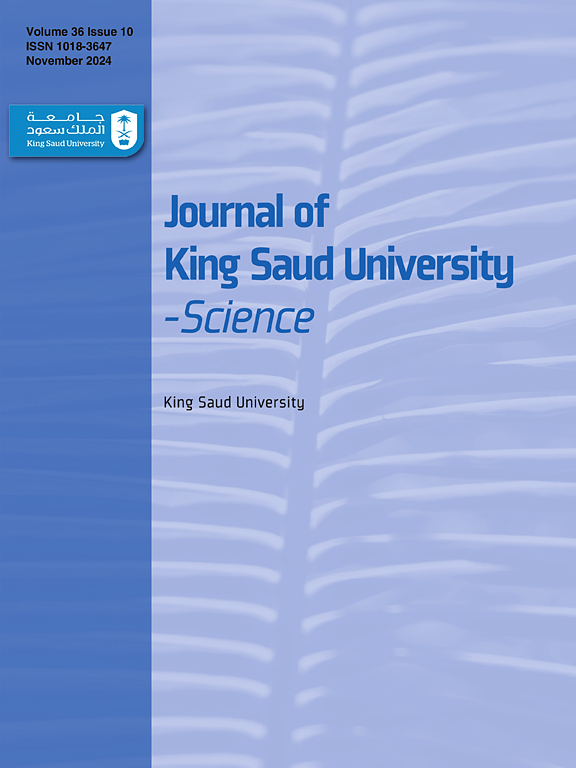Characterization of tin oxide nanoparticles synthesized by discharging the non-thermal plasma jet in liquid and their application as an antibacterial agent
IF 3.6
3区 综合性期刊
Q1 MULTIDISCIPLINARY SCIENCES
引用次数: 0
Abstract
This study reports the synthesis of tin oxide nanoparticles using a non-thermal plasma jet technique. Spectroscopic analysis (OES) of plasma was carried out at atmospheric pressure to measure the plasma parameters used in the synthesis of nanoparticles. SnO2 NPs were synthesized at different durations (3 and 5 min) using a DC-high-voltage power source with a voltage of 13 kV.
X-ray diffraction (XRD) showed that SnO2 NPs, prepared in 3 min, are rutile tetragonal polycrystalline and have an average crystallite size of 12.45 nm. Field emission scanning electron (FE-SEM) images also show that the nanoparticles are spherical and homogenous, with an average nanostructure diameter of 22 to 58 nm for both (3 and 5 min) preparation times. UV–Vis spectroscopy showed peaks of surface plasmon resonance around 255–260 nm. The ICP-mass technique was used to evaluate nanoparticle concentrations, which were between 90–100 μg/ml. Zeta potential (ZP) measurements revealed that the particles are relatively stable colloids. The study shows that synthesized nanoparticles have exceptional antibacterial efficacy against Escherichia coli and Staphylococcus aureus bacteria. These nanoparticles are low-cost, scalable, and can be synthesized using gas or liquid phases, enabling the synthesis of a wide range of nanoparticles suitable for various pathogenic bacterial types.
非热等离子体射流在液体中放电合成氧化锡纳米颗粒的表征及其抗菌应用
本研究报道了利用非热等离子体喷射技术合成氧化锡纳米颗粒。在常压下对等离子体进行了光谱分析(OES),测量了用于纳米颗粒合成的等离子体参数。使用电压为13 kV的直流高压电源,在不同的持续时间(3和5 min)下合成SnO2 NPs。x射线衍射(XRD)结果表明,在3 min内制备的SnO2 NPs为金红石型四边形多晶,平均晶粒尺寸为12.45 nm。场发射扫描电子(FE-SEM)图像也表明,纳米颗粒呈球形且均匀,在3和5 min的制备时间内,纳米结构的平均直径为22 ~ 58 nm。紫外可见光谱显示表面等离子体共振峰在255 ~ 260 nm附近。采用ICP-mass技术测定纳米颗粒浓度,浓度范围为90 ~ 100 μg/ml。Zeta电位(ZP)测量表明,该颗粒是相对稳定的胶体。研究表明,合成的纳米颗粒对大肠杆菌和金黄色葡萄球菌具有优异的抗菌效果。这些纳米颗粒成本低,可扩展,并且可以使用气相或液相合成,从而可以合成适用于各种致病菌类型的广泛纳米颗粒。
本文章由计算机程序翻译,如有差异,请以英文原文为准。
求助全文
约1分钟内获得全文
求助全文
来源期刊

Journal of King Saud University - Science
Multidisciplinary-Multidisciplinary
CiteScore
7.20
自引率
2.60%
发文量
642
审稿时长
49 days
期刊介绍:
Journal of King Saud University – Science is an official refereed publication of King Saud University and the publishing services is provided by Elsevier. It publishes peer-reviewed research articles in the fields of physics, astronomy, mathematics, statistics, chemistry, biochemistry, earth sciences, life and environmental sciences on the basis of scientific originality and interdisciplinary interest. It is devoted primarily to research papers but short communications, reviews and book reviews are also included. The editorial board and associated editors, composed of prominent scientists from around the world, are representative of the disciplines covered by the journal.
 求助内容:
求助内容: 应助结果提醒方式:
应助结果提醒方式:


